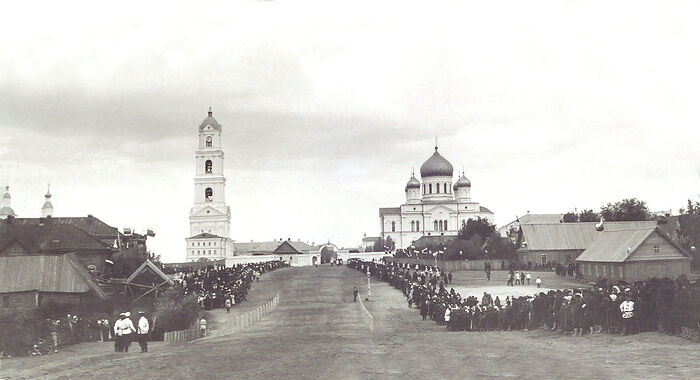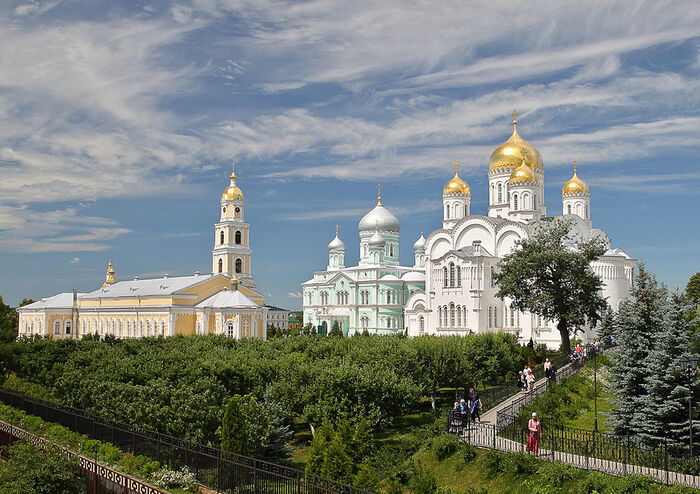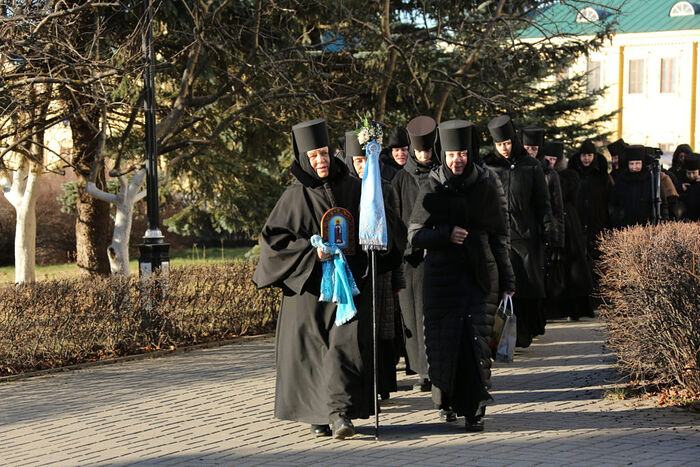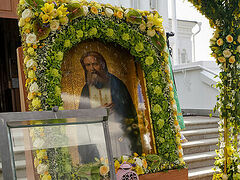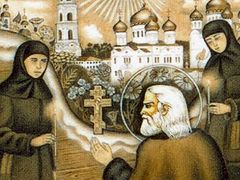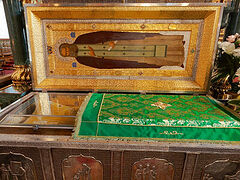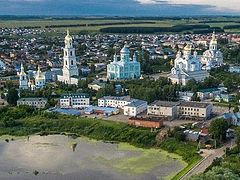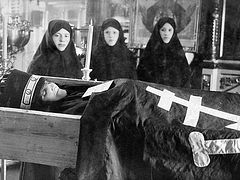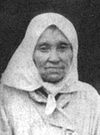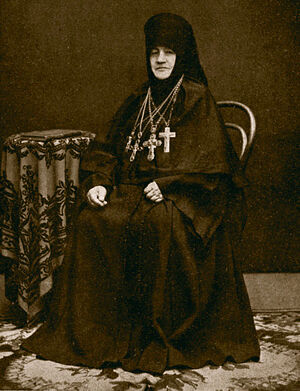 Abbess Maria’s portrait on her 40th anniversary as abbess There is a well-known prophecy of St. Seraphim of Sarov about the first abbess of Diveyevo—long before she arrived at the monastery, he named her by her first and last name, describing her as a righteous nun. Abbess Maria (Ushakova) was assigned to lead the monastery at a challenging time after what would later be known as the “Time of Troubles in Diveyevo” stirred up by novice Ivan Tolstosheev from Sarov and his followers. Herself a novice at the time, she lived honorably through that period of turmoil. Under Maria Ushakova as abbess, the monastery flourished and a thousand sisters resided there, the Trinity Cathedral was built along with other numerous buildings, and St. Seraphim of Sarov was glorified among the saints. Her whole life as abbess serves as an example of monastic service to God and the Queen of Heaven. We talked about Abbess Maria with Abbess Sergia (Konkova), the abbess of the Holy Trinity St. Seraphim-Diveyevo monastery.
Abbess Maria’s portrait on her 40th anniversary as abbess There is a well-known prophecy of St. Seraphim of Sarov about the first abbess of Diveyevo—long before she arrived at the monastery, he named her by her first and last name, describing her as a righteous nun. Abbess Maria (Ushakova) was assigned to lead the monastery at a challenging time after what would later be known as the “Time of Troubles in Diveyevo” stirred up by novice Ivan Tolstosheev from Sarov and his followers. Herself a novice at the time, she lived honorably through that period of turmoil. Under Maria Ushakova as abbess, the monastery flourished and a thousand sisters resided there, the Trinity Cathedral was built along with other numerous buildings, and St. Seraphim of Sarov was glorified among the saints. Her whole life as abbess serves as an example of monastic service to God and the Queen of Heaven. We talked about Abbess Maria with Abbess Sergia (Konkova), the abbess of the Holy Trinity St. Seraphim-Diveyevo monastery.
—Mother Abbess, we know from St. Seraphim’s prophecy that the maiden Elizaveta Alexeyevna Ushakova was to become the first abbess of Diveyevo. What in particular did the holy elder foresee in her?
—Anything St. Seraphim has ever said or prophesied wasn’t simply words; everything was inspired by the Holy Spirit. Batushka Seraphim had foreknowledge that one day we would have a righteous mother with the surname Ushakova, and so we embrace it as a blessing from God and the Queen of Heaven passed on through the holy elder. We of the twenty-first century are witnesses to the fulfillment of this prophecy. Truly, Abbess Maria (Ushakova) was the first abbess of our monastery. We are aware of what she had to endure on her path.
—“She was like a fired brick”—that’s how Abbess Maria was described at the time of the twenty-fifth anniversary celebration of her abbacy. What events tempered her spirit?
—Undoubtedly, the challenges our monastery experienced during the time of trouble tempered her spirit. Not only did she survive the turmoil by simply never blaming or accusing anyone, but she also submitted firmly to the will of God and stuck to the truth, as it was confirmed by our blessed women now glorified as saints. Anywhere there is truth, there is the Truth. Anywhere there is deception, that’s where the opposite forces reign supreme. As we know, the deceitful spirit shook our monastery to the core and caused so much strife that the precepts of St. Seraphim were completely overthrown. But St. Seraphim never spoke of his own will, as he testified that no stone has ever been turned in Diveyevo without the command from the Queen of Heaven.
When the former novice Ivan Tolstosheev from Sarov meddled in the life of our monastery, boasting that he was St. Seraphim’s disciple, he tried to destroy every single precept left by the holy elder. And it all would have eventually led to the destruction of the fourth portion of the Mother of God. This shows that we wrestle not against flesh and blood, but against principalities, against powers, against the rulers of the darkness of this world, against spiritual wickedness in high places (Ephesians 6:12). Our monastery lived through just such a time when Elizaveta Alexeevna Ushakova lived there. She came to the monastery as a novice because of her love of God, and to serve the monastic community destined to become, according to the words of Batiushka Seraphim, a monastery of the Queen of Heaven; and she did serve it with great zeal. Her soul was honest, sincere, and absolutely free of deceit. From the onset of her life as a monastic, novice Elizaveta chose to trust the eldresses appointed by the Queen of Heaven and admitted to the community by Fr. Seraphim. From the community eldresses, she received the perfect knowledge of the great elder’s precepts. Having learned how all his instructions were made according to the will of the Mother of God, her love of Elder Seraphim and the adherence to his precepts became the foundation of her future life in the monastery. It took her fifteen years of going from strength to strength as a monastic to grow spiritually and evolve to become a future abbess. Elizaveta Alexeevna completed her toilsome path and the fruits of her labor became so obvious that after having a conversation with her, Metropolitan Philaret, known for his strictness, wrote the following in his letter to Alexey Petrovich Akhmatov, Chief Procurator of the Holy Synod: “This letter will be presented to Your Excellence by Abbess Maria of Diveyevo, an eldress, in apostolic words, of a meek and quiet spirit. Grace her with your attention.”
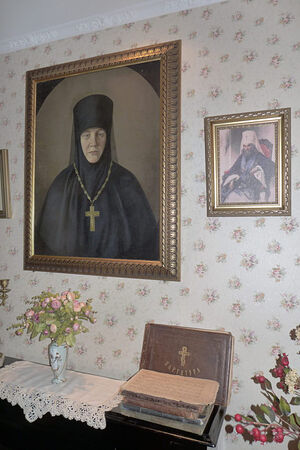 Never seeking a superior position in the monastery, Elizaveta Alexeevna, against her own wishes at times, was appointed to administrative positions at first as a provisor nun, and later as abbess of the monastery. Hoping to find support for her desire to keep to the prayer-focused life, she went to seek advice from a clairvoyant elder Anthony Groshovnik. But the elder promptly announced that she must become the mother abbess. Furthermore she had to obey, or else she would be expelled from the monastery and would not have found salvation. Elizaveta Alexeevna had thus met a challenge and bore her cross. As St. Seraphim testified, not even a single sister was ever accepted to the community without a blessing from the Mother of God. All the more, this rule relates in its entirety to Elizaveta Ushakova, who became not only a nun of the Diveyevo monastery but its abbess. Her selection was made exclusively and solely according to the will of the Queen of Heaven Herself.
Never seeking a superior position in the monastery, Elizaveta Alexeevna, against her own wishes at times, was appointed to administrative positions at first as a provisor nun, and later as abbess of the monastery. Hoping to find support for her desire to keep to the prayer-focused life, she went to seek advice from a clairvoyant elder Anthony Groshovnik. But the elder promptly announced that she must become the mother abbess. Furthermore she had to obey, or else she would be expelled from the monastery and would not have found salvation. Elizaveta Alexeevna had thus met a challenge and bore her cross. As St. Seraphim testified, not even a single sister was ever accepted to the community without a blessing from the Mother of God. All the more, this rule relates in its entirety to Elizaveta Ushakova, who became not only a nun of the Diveyevo monastery but its abbess. Her selection was made exclusively and solely according to the will of the Queen of Heaven Herself.
—You quoted St. Philaret of Moscow who characterized Maria using the words of the apostle, that she is “of a meek and quiet spirit”, and also referred to her conversation with St. Anthony Groshovnik. Other saints, such as the holy hierarch Theophan the Recluse and St. Anthony (Medvedev), were kindly disposed towards Mother Maria, as well. What do these saints’ opinions of her mean?
—They mean that she was living the spiritual life. She never sought honors for herself or the comforts of this life, but sought only God’s will. When someone leads a spiritual life, it attracts everyone around. We always marvel at those who have the heavenly leaven, or the grace of God, and we try to listen to them. There were such prominent people in our lives as well: Fr. John (Krestiankin) or Fr. Nicholai from the Island of Zalit, or the elders of the Holy Trinity-St. Sergius Lavra. We are always drawn to them, because through them, the will of God is revealed to us and their words are of the Holy Spirit. Meeting them is like partaking of living waters for our spiritual life.
—The situation was so rough in the monastery during the time of turmoil, and the sisters were all different, many of them in direct opposition to Mother Maria. But according to the testimony of the Holy Synod, she never spoke ill of any of them when asked to describe them. How is that possible? For there were some nuns who openly went against her, while others half-heartedly neglected her.
—Anyone leading the spiritual life submits everything to God and thus becomes an eager fulfiller of sacred law. Like Batiushka Seraphim said, “To teach” means to throw rocks from a bell tower but “to do” is to carry the rocks back to the top of a bell tower. So, Abbess Maria was a doer of the law. She labored hard to ascend the spiritual heights and achieved so much with God’s help that she never condemned anyone, fulfilled the will of the Queen of Heaven, and emerged a victor out of the time of trouble. It was noted that she lived to an advanced age, to see the glorification of Batiushka Seraphim in 1903, and to greet the Royal Family when they arrived in Diveyevo. Then, having completed this task of great importance, she reposed in the Lord in 1904 as a righteous one, who had fulfilled everything she was preordained to do.
—We all know the outcome of Abbess Maria Ushakova’s life. But what details are known about it? Are there any historical accounts about her spiritual life?
—Abbess Maria was known for her modesty. There are a few details we can find in the records written by the sisters with the blessing of their abbess. For example, a copy of the akathist to the Passion of the Lord has been preserved to our time. It is revealing that she found it necessary to copy that particular akathist, and it appears that she read it often, because the work of our salvation was completed by the Lord through His sufferings on Golgotha. We can only obtain salvation through trials. She didn’t just write a copy of this akathist, but it arose from her thankful heart that loved God.
—St. Seraphim said that in due course, the relics of four saints would rest in the Church of the Nativity of the Mother of God. This church is supported by four pillars. The relics of three saints are already there, only one is missing. Can we hope that those last ones will be the relics of Abbes Maria Ushakova?
—Everything is in God’s hands. We are hopeful that it will happen and Abbess Maria Ushakova will be the last one laid to rest in this church. The Lord gives us time to pray about it. We can already see how all of St. Seraphim’s prophecies are being fulfilled in our monastery. I for example thought at the time that the glorification of our venerable mothers Alexandra, Martha, and Elena couldn’t possibly take place in our lifetime. But as you see, it has happened and their relics were uncovered. Our blessed women saints were glorified. We now have so many new helpers and intercessors in the Heavenly Diveyevo!
When we first arrived here, we couldn’t even fathom that Diveyevo monastery would appear as it does now. The local authorities used to tell us: “Well, we gave them two churches, what else do they need?” The rest of the buildings were occupied by various organizations or used as apartment buildings. It seemed as if we’d need not less than a century to vacate all of them. However, what’s impossible for man is possible with God. Once Batiushka Seraphim had arrived here in his relics, everything was truly and wondrously fulfilled. Where else could you see that villages of only seven or eight thousand inhabitants, like Diveyevo, are included in the federal riverbank improvement project with our lands returned down to the riverbank? But it was one of Batiushka Seraphim’s prophecies. He used to say that the area running from the monastery down to the riverbank must belong to us. In his time, that area was privately owned; it was used for planting vegetable gardens. During Soviet times, it was occupied by buildings of the public prosecutor’s office, the central bank, and the police headquarters, with two more buildings for the local administration. There were also a café and a department store. How could we relocate it all? But now all these buildings have been transferred to the monastery. What is impossible for man is possible with God and the Queen of Heaven.
I feel like weeping, knowing how unworthy we are; but the Lord has revealed so much grace in the fourth portion of the Mother of God! I used to think: How can it be possible that the grace of all four earthly portions of the Queen of Heaven can be brought to Diveyevo? There is Georgia revered for its holy sites. There is Mount Athos, the monastic republic, and men from all over the world reside on that holy mountain and glorify God and the Queen of Heaven. From, Athos, Her third portion, all holiness was distributed throughout the rest of Rus’. And then, all of a sudden, all this grace will come together in the fourth portion! And truly, Batiushka Seraphim’s prophecy was fulfilled that once he would arrive in Diveyevo, this village would become known as “divo” (meaning “wonder” in English.—Trans.), and that everyone would wonder where all of Diveyevo’s grandeur came from. Really, where does all of it come from? The Lord sends us everything at the right moment. Even our hierarch! Because who else but our metropolitan could have ever accomplish such a grandiose task back in 2003?! But God knew who should be sent to us. We rely on God’s mercy as we prayerfully walk along the renovated Canal, or serve the akathist to Batiushka Seraphim before his holy relics every day. We also have a great host of saints from the land of Diveyevo who intercede for us in heaven. They are our venerable mothers, the blessed women, the monastic martyrs, confessors of faith, and holy hieromartyrs.
—There were three abbesses recorded in the annals of the history of the Seraphim-Diveyevo monastery: Abbess Maria, Abbess Alexandra, and yourself. How does the experience of your predecessors help you in your service?
—I must say that the service of Abbess Maria Ushakova is a rock I can lean on, and as I mentioned before, what she had to endure during the time of trouble and how gracefully she withstood that spiritual warfare teaches a really good lesson. Abbess Alexandra Trakovskaya endured the dissolution of the monastery together with the sisters and fearlessly confessed the faith, having saved all the holy relics and holy objects from Diveyevo.1 She, with other Diveyevo sisters of that period, protected the faith and kept all the precepts of Batiushka Seraphim through the years, having shown an example of faithfulness to Christ and their monastic vows in the vacuum of a godless regime. The spiritual podvigs of the Russian new martyrs and confessors of the faith prepared the rebirth of our Church, so that it could become the mighty ship it is today.
—Do you turn to Abbess Maria or Abbess Alexandra in prayer?
—Whenever I walk past their graves I always ask for their prayerful intercession, and we serve a litiya for their repose on their commemoration days. And we truly receive help.

